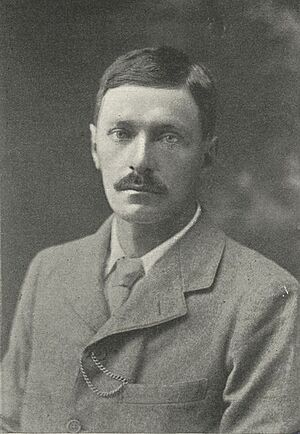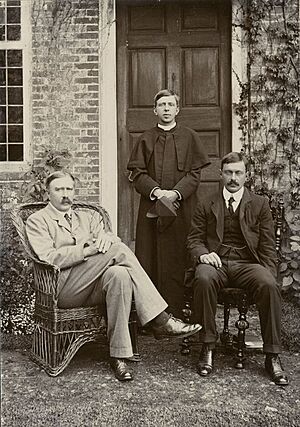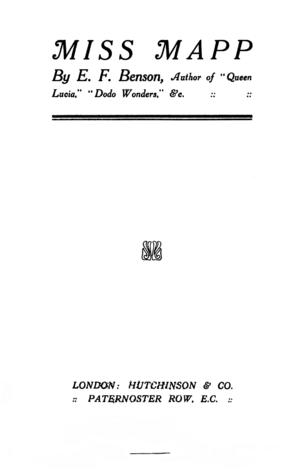E. F. Benson facts for kids
Quick facts for kids
E. F. Benson
|
|
|---|---|
 |
|
| Born | Edward Frederic Benson 24 July 1867 Wellington College, Berkshire, England |
| Died | 29 February 1940 (aged 72) University College Hospital, London, England |
| Occupation | Writer |
| Notable works |
|
| Notable awards | OBE |
| Relatives | Edward White Benson (father) Mary Benson (mother) Robert Hugh Benson (brother) A. C. Benson (brother) Margaret Benson (sister) |
Edward Frederic Benson OBE (born 24 July 1867 – died 29 February 1940) was an English writer. He wrote many novels, biographies, history books, and short stories. He is best known for his funny Mapp and Lucia books and his spooky ghost stories.
Contents
Early Life and Family
Edward Frederic Benson, often called E. F. Benson, was born at Wellington College in England. He was the fifth child in his family. His father, Edward White Benson, was a very important church leader. He later became the Archbishop of Canterbury, which is a top position in the Church of England. His mother was Mary Sidgwick.
E. F. Benson had two older brothers who were also famous writers: Arthur Christopher Benson and Robert Hugh Benson. Arthur wrote the words for the famous song "Land of Hope and Glory". His sister, Margaret Benson, was an author and studied ancient Egypt. Sadly, two of his other siblings died when they were young.
Benson went to Temple Grove School and then Marlborough College. He wrote some of his first stories while at Marlborough. This school also inspired his novel David Blaize. He then studied at King's College, Cambridge, a famous university.
His Books and Stories
E. F. Benson was a very busy writer and wrote many books. His first book was Sketches from Marlborough, which he wrote while still a student. His first novel was Dodo (1893), which became popular right away. He wrote more books that were funny or had romantic and spooky themes. He later wrote two more books about the character Dodo: Dodo the Second (1914) and Dodo Wonders (1921). These books show what life was like for young, fashionable people before and during World War I.
One of his most famous series is the Mapp and Lucia books. These are six novels and two short stories about funny social rivalries in a small English town. The novels include Queen Lucia, Miss Mapp, Lucia in London, Mapp and Lucia, Lucia's Progress, and Trouble for Lucia.
Benson was also well-known for his spooky and sometimes funny ghost stories. These stories often appeared in magazines like Pearson's Magazine. He called them "spook stories." Many of them were collected and published in books. One of his short stories, "The Bus-Conductor" (1906), is about a person who has a scary feeling about a hearse driver. This story has been made into films several times.
He also wrote a children's fantasy story called David Blaize and the Blue Door (1918). This book was inspired by the works of Lewis Carroll, who wrote Alice in Wonderland. Another interesting story is "Mr Tilly's Seance," which is a funny tale about a man who finds himself on the "other side" after an accident.
Benson also wrote biographies about famous people, like Charlotte Brontë, who wrote Jane Eyre. His very last book was an autobiography called Final Edition, which he finished just before he died.
Life in Rye, East Sussex
The main town in four of the Mapp and Lucia books is called Tilling. This town is actually based on Rye, East Sussex, a real town where Benson lived from 1918. He even became the mayor of Rye in 1934.
Benson's home in Rye was called Lamb House. This house became the model for "Mallards," the home of characters Miss Mapp and later Lucia in his books. Lamb House has a rich history and was also home to other famous writers like Henry James.
Benson gave a special gift to the main church in Rye, St Mary's. He donated a church window in memory of his brother. He also provided a viewing platform that looks out over the town's salt marshes.
Personal Life and Interests
Benson was a talented athlete. He even represented England in figure skating.
In London, Benson lived at 395 Oxford Street. This address was also used as a setting in his book Lucia in London. A special Blue Plaque was placed on the building in 1994 to honor him.
Death
E. F. Benson passed away on 29 February 1940. He died from throat cancer at University College Hospital in London. He is buried in the cemetery in Rye, East Sussex, the town he loved so much.
Books and Stories on Screen and Radio
Many of E. F. Benson's stories have been made into films, TV shows, and radio plays:
- "The Hearse Driver" was a part of the film Dead of Night (1945). It was based on his short story "The Bus-Conductor."
- "Mrs. Amworth" was a part of the film Three Dangerous Ladies (1977).
- Trouble for Lucia was a 12-part radio show on BBC Radio 4 in 1983, based on the first four Mapp and Lucia novels.
- The Mapp & Lucia TV series (1985–1986) was very popular. It starred Geraldine McEwan as Lucia and Prunella Scales as Mapp.
- Another radio adaptation of Mapp and Lucia was broadcast on BBC Radio 4 in 2007.
- Lucia's Progress was a five-part radio dramatization in 2008.
- A new Mapp & Lucia miniseries (2014) was shown on BBC One. It starred Miranda Richardson as Mapp and Anna Chancellor as Lucia.
New Stories
Other authors have written new "Mapp and Lucia" books, continuing the series after Benson's death. These authors include Tom Holt, Guy Fraser-Sampson, and Ian Shepherd.




